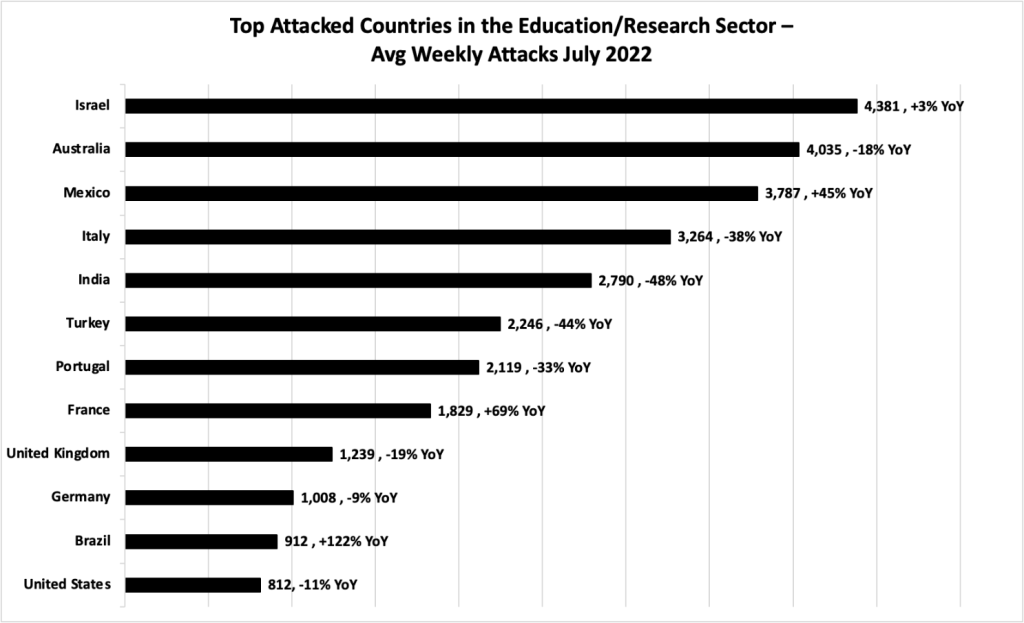Highlights:
- Education/Research sector worldwide experienced the highest volumes of attacks every month in 2022 and in 2021.
- In July 2022, the Education/Research sector shows more than double the number of weekly cyberattacks compared to the other industries’ average.
- Latin America has seen the largest increase in weekly cyber-attacks in the month of July 2022 with a 62% increase, compared to July 2021.
Check Point Research (CPR) recently published its Cyber Attack Trends: 2022 Mid-Year Report which reported that similar to 2021’s top industry ranking, the first half of 2022 displays significant rises in attacks across all sectors.
Topping them all, Education and Research still leads as the most targeted industry, with an average of 2,297 attacks against organizations every week in the 1H of 2022, showing a 44% increase compared to the 1H of 2021.In today’s report, we shed some more insights to that sector, and present indepth though alarming numbers.
Education/Research sees A 114% increase in the last 2 years
According to CPR, the Education/Research sector experienced the highest volumes of attacks every month in 2022 and in 2021 worldwide.
In July 2022, the Education/Research sector shows more than double the number of weekly cyber-attacks compared to the other industries’ average. This sector had an average of almost 2,000 attacks per organization every week (a 6% increase compared to July last year and 114% increase compared to July two years ago). Such attacks can have devastating consequences like the case of Lincoln College, which after suffering a ransomware attack was the final straw that contributed to their decision to shut down on May 13 2022, after 157 years.
ANZ is the most attacked region in July 2022
When we break down the numbers to education attacks by region in July 2022, we see that ANZ was the most heavily attacked region with 4,176 attacks per organization every week (7% decrease compared to July 2022), followed by Asia with 4,171 attacks (5% increase), and Europe with 1,861 attacks (6% decrease).
Latin America has seen the largest increase in weekly cyberattacks with a 62% increase compared to July 2021.

Brazil sees a 122% increase YoY, Israel sees highest amount of weekly average attacks
In terms of attack by country, in July 2022, Israel absorbed the highest number of attacks worldwide with a weekly average of 4,381 attacks per organization, an 3% increase compared to July 2021. This was followed by Australia with 4,035 attacks on average per week (18% decrease YoY) and Mexico with an average of 3,787 weekly attacks (45% increase compared to July 2021).
Brazil has seen the largest increase in weekly cyber-attacks with a 122% increase compared to July 2021. The next country that suffered the biggest increase in cyber-attacks is France, with a 69% increase YoY.
In the United States, An organization in the education/research sector suffered from an average of 812 weekly cyber-attacks. This is a slight decrease of 11% compared to July 2021, though during the past month we have seen a steady upwards trend, with the last week reaching similar numbers as last year.

Staying protected against cyber-attacks, tips for schools and students
- Be phishing-aware: be wary of clicking on links that look in any way suspicious and only download content from reliable sources that can be verified. Remember that phishing schemes are a form of social engineering so if you receive an email with an unusual request, check the sender’s details carefully to make sure that you are communicating with colleagues, not cyber criminals.
- Anti-ransomware technology allows you to detect signs of ransomware and uncover running mutations of known and unknown malware families by using behavioral analysis and generic rules
- Passwords matter: It is a good idea to review and strengthen passwords that you use for logging onto remote resources, such as email or work applications.
- Beware of lookalike domains, spelling errors in emails or websites, and unfamiliar email senders.
- Deploy Email Security Solutions- Modern email filtering solutions can protect against malware and other malicious payloads in email messages. Solutions can detect emails that contain malicious links, attachments, spam content, and language that could suggest a phishing attack. Email security solutions automatically block and quarantine suspicious emails and use sandboxing technology to “detonate” emails to check if they contain malicious code.
How Can Check Point Help
Check Point’s Anti-Ransomware technology uses a purpose-built engine that defends against the most sophisticated, evasive zero-day variants of ransomware and safely recovers encrypted data, ensuring business continuity and productivity. Harmony Endpoint, Check Point’s leading endpoint prevention and response product, includes Anti-Ransomware technology and provides protection to web browsers and endpoints, leveraging Check Point’s industry-leading network protections. Harmony Endpoint delivers complete, real-time threat prevention and remediation across all malware threat vectors
*Disclamier: "The pages slugged ‘Press Release’ are equivalent to advertisements and are not written and produced by Industry Outreach Magazine journalists/Editorial." We do not hold any copyrights towards the content or image. Image source: Newswire







